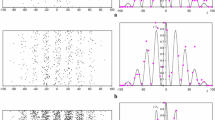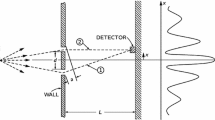Abstract
In this paper, I argue that we can avoid the paradoxes connected with the wave-particle duality if we consider some classical wave field—“an electron wave”—instead of electrons as the particles and consider the wave equations (Dirac, Klein–Gordon, Pauli and Schrödinger) as the field equations similar to Maxwell equations for the electromagnetic field. It is shown that such an electron field must have an electric charge, an intrinsic angular momentum and an intrinsic magnetic moment continuously distributed in the space. In this case, no paradoxes are associated with the infinite electromagnetic energy of the “electron” and its anomalous from the standpoint of the classical electrodynamics gyromagnetic ratio. It is shown that from this perspective, the double-slit experiment, the Born rule, the Heisenberg uncertainty principle and the Compton effect all have a simple explanation within classical field theory. The proposed perspective allows consideration of quantum mechanics not as a theory of particles but as a classical field theory similar to Maxwell electrodynamics.
Similar content being viewed by others
References
Tonomura, A., Endo, J., Matsuda, T., Kawasaki, T., Ezawa, H.: Demonstration of single-electron build-up of an interference pattern. Am. J. Phys. 57, 117–120 (1989)
Taylor, G.I.: Interference fringes with feeble light. Proc. Camb. Philos. Soc. 15(1), 114–115 (1909)
Dimitrova, T.L., Weis, A.: The wave-particle duality of light: a demonstration experiment. Am. J. Phys. 76(2), 137–142 (2008)
Zurek, W.H.: Environment-assisted invariance, entanglement, and probabilities in quantum physics. Phys Rev Lett 90, 120404 (2003)
Zurek, W.H.: Probabilities from entanglement, Born’s rule \(p_{k} =\left| {\psi _{k} } \right|^{2}\) from envariance. Phys. Rev. A 71, 052105 (2005)
Schlosshauer, M., Fine, A.: On Zurek’s derivation of the Born rule. Found. Phys. 35(2), 197–213 (2005)
Tegmark, M.: The interpretation of quantum mechanics: many worlds or many words? Fortschritte der Physik 46, 855–862 (1998)
Holland, P.R.: The Quantum Theory of Motion: An Account of the de Broglie–Bohm Causal Interpretation of Quantum Mechanics. Cambridge University Press, Cambridge (1995)
Auletta, G.: Foundations and Interpretation of Quantum Mechanics. World Scientific, Singapore (2000)
Bacciagaluppi, G.: The Modal Interpretation of Quantum Mechanics. Cambridge University Press, Cambridge (2006)
Bohm, D., Hiley B.J.: The Undivided Universe: An Ontological Interpretation of Quantum Theory. Routledge, UK (2006)
Ballentine, L.E.: The statistical interpretation of quantum mechanics. Rev. Mod. Phys. 42(4), 358 (1970)
Cramer, J.G.: The transactional interpretation of quantum mechanics. Rev. Mod. Phys. 58(3), 647 (1986)
Omnès, R.: Consistent interpretations of quantum mechanics. Rev. Mod. Phys. 64(2), 339 (1992)
Schlosshauer, M.: Decoherence, the measurement problem, and interpretations of quantum mechanics. Rev. Mod. Phys. 76(4), 1267 (2005)
Rashkovskiy, S.A.: A rational explanation of wave-particle duality of light. In: SPIE Optical Engineering \(+\) Applications (pp. 88321O–88321O). International Society for Optics and Photonics, UK (2013)
Rashkovskiy, S.A.: Quantum mechanics without quanta: the nature of the wave-particle duality of light. Quantum Stud.: Math. Found. 3, 147–160 (2016). doi:10.1007/s40509-015-0063-5
Rashkovskiy, S.A.: Are there photons in fact? In: Proc. SPIE. 9570, The Nature of Light: What are Photons? vol. VI, p. 95700G (2015). doi:10.1117/12.2185010
Rashkovskiy, S.A.: Semiclassical simulation of the double-slit experiments with single photons. In: Progress of Theoretical and Experimental Physics 2015(12), 123A03 (2015). doi:10.1093/ptep/ptv162
Landau, L.D., Lifshitz, E.M.: The Classical Theory of Fields, vol. 2, 4th ed. Butterworth-Heinemann, UK (1975)
Schmutzer, E.: Grundprinzipien der klassischen Mechanik und der klassischen Feldtheorie (kanonischer Apparat). VEB Deutscher Verlag der Wissenschaften, Berlin (1973). (in German)
Takabayasi, T.: On the hydrodynamical representation of non-relativistic spinor equation. Prog. Theor. Phys. 12(6), 810–812 (1954)
Takabayasi, T.: The vector representation of spinning particle in the quantum theory, I. Prog. Theor. Phys. 14(4), 283–302 (1955)
Takabayasi, T., Vigier, J.-P.: Description of Pauli matter as a continuous assembly of small rotating bodies. Prog. Theor. Phys. 18(6), 573–590 (1957)
Takabayasi, T.: Relativistic hydrodynamics equivalent to the Dirac equation. Prog. Theor. Phys. 13(2), 222–224 (1955)
Takabayasi, T.: Hydrodynamical description of the Dirac equation. Il Nuovo Cimento 3(2), 233–241 (1956)
Takabayasi, T.: Theory of the Dirac Field as a Continuous Assembly of Small Rotating Bodies, Il Nuovo Cimento, vol. VII, No. 1, pp. 118–121 (1958)
Landau, L.D., Lifshitz, E.M.: Quantum Mechanics: Non-Relativistic Theory, vol. 3, 3rd ed. Pergamon Press, Oxford (1977)
Messiah, A.: Quantum Mechanics. Dover Publications Inc., New York (1999)
Born, M., Wolf, E.: Principles of Optics: Electromagnetic Theory of Propagation. Interference and Diffraction of Light. Cambridge University Press, Cambridge (1999)
Dirac, P.A.M.: Relativity Quantum Mechanics with an Application to Compton Scattering. Proc. R. Soc. Lond. A. 111, 405–423 (1926)
Dirac, P.A.M.: The compton effect in wave mechanics. Proc. Cambr. Phil. Soc. 23, 500–507 (1926)
Der, Gordon W.: Comptoneffekt nach der Schrödingerschen Theorie. Zeit. F. Phys. 40, 117–133 (1926)
Klein, O., Nishina, Y.: Über die Streuung von Strahlung durch freie Elektronen nach der neuen relativistischen Quantendynamik von Dirac. Z. Phys. 52(11–12), 853–869 (1929)
Klein, O., Nishina, Y.: On the scattering of radiation by free electrons according to Dirac’s new relativistic quantum dynamics. In: The Oskar Klein Memorial Lectures: 1988–1999, vol. 1, pp. 253-272 (2014)
Schrödinger, E.: Uber den Comptoneffekt. Ann. Physik 82, 257–264 (1927)
Sommerfeld, A.: Wave-Mechanics: Supplementary Volume to Atomic Structure and Spectral Lines. Dutton, New York (1934)
Mead, C.: Collective Electrodynamics: Quantum Foundations of Electromagnetism. MIT Press, New York (2002)
Acknowledgments
Funding was provided by Tomsk State University competitiveness improvement program.
Author information
Authors and Affiliations
Corresponding author
Rights and permissions
About this article
Cite this article
Rashkovskiy, S.A. Quantum mechanics without quanta: 2. The nature of the electron. Quantum Stud.: Math. Found. 4, 29–58 (2017). https://doi.org/10.1007/s40509-016-0085-7
Received:
Accepted:
Published:
Issue Date:
DOI: https://doi.org/10.1007/s40509-016-0085-7
Keywords
- Electron
- Wave-particle duality
- Classical field theory
- Double-slit experiment
- Born rule
- Heisenberg uncertainty principle
- Compton effect




